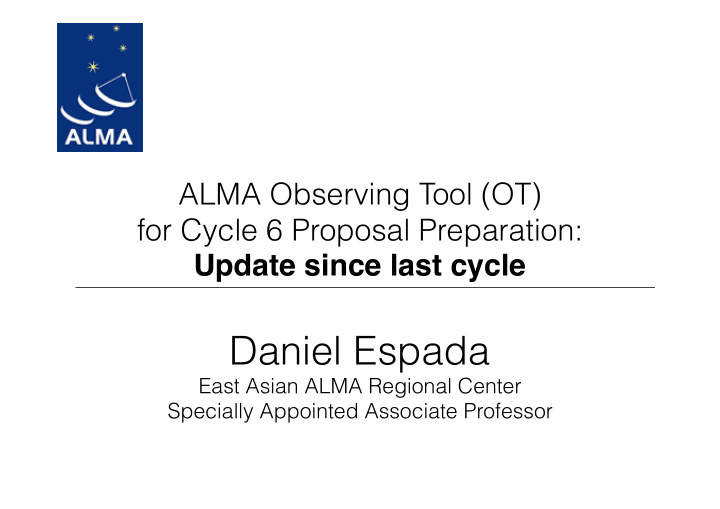



ALMA Observing Tool (OT) for Cycle 6 Proposal Preparation: Update since last cycle Daniel Espada East Asian ALMA Regional Center Specially Appointed Associate Professor
1) JAVA version • OT will only work using Java 8 (64 bit) . Java 9 has been recently released, but this should not be used.
2) Resubmitting previous projects Now possible to convert between normal and DDT proposals
2) Resubmitting previous projects Now possible to convert between normal and DDT proposals
3) Galactic coordinates • OT had partially supported Galactic coordinates for some time, but now this is improved: • The spatial visualizer displays externally loaded fits in Galactic coordinates and will convert between different coordinate systems. • Source coordinates that are read via a text file are interpreted in Galactic if they are in decimal degrees.
4) Circular polarization • The spectral setup is defined in exactly the same way as for linear polarization, but separate estimates of the continuum and linear polarization of the source should now be entered. • OT enforces lower limits on the allowed polarization percentage (different for circular and linear). For circular it is 1.8%.
5) Circular polarization New fields in ‘Expected Source Properties’ in Field setup
6) Band 8 • Band 8 observations become standard • Therefore Band 8 observations are now possible with ACA standalone
7) Band 6 IF range • Since Cycle 0, the IF range of band 6 has been 5 - 10 GHz, but it has been extended by 0.5 GHz (i.e. 4.5 - 10 GHz). • It is now easier to observe the spectral setup with CO, 13CO and C18O(2-1) lines
8) Correlator data rates • The OT now enforces a strict upper limit of 70 MB/s for the (peak) data rate assuming 50 antennas (maximum that might be used, although sensitivity calculations are based on 43 antennas) • If limit is exceeded, then spectral averaging should be used (or spectral windows removed) until validation error disappears
9) Simultaneous 12m+ACA • In addition to specific time windows and multiple visits, you can also request that the 12m and ACA observations are executed simultaneously using a tick box. • In that case 7m/TP time will be as for the 12m array • Only allowed if only one 12m configuration required
9) Simultaneous 12m+ACA • In addition to specific time windows and multiple visits, you can also request that the 12m and ACA observations are executed simultaneously using a tick box. • In that case 7m/TP time will be as for the 12m array • Only allowed if only one 12m configuration required
Other changes • 10) If multiple sources, groups are done within a radius of 10 deg, except for Long baseline configurations, where the radius is 1 deg • 11) LSRK to barycentric correction now works properly for all velocity definitions • 12) Minimum time on source (adding all sources in a given Scheduling Block) will be the largest of 5 min or 50% of the total calibration time (amplitude and bandpass)
Recommend
More recommend